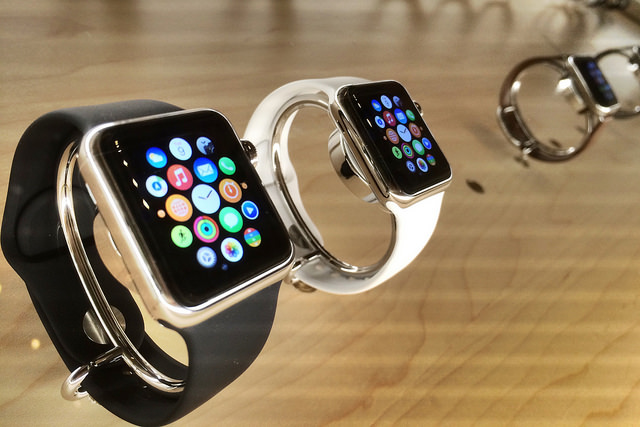With Apple’s recent Spring Forward event, it’s no secret Apple Watch is on the menu.
The latest Apple product joins Pebble and Samsung’s smartwatches and Google Glass as pairable-wearables to mobile apps. But are smartwatch apps useful to commerce? Examples are few and far between, but the following all have something in common.
Domino’s
Android Wear and Pebble smartwatch owners can now order that Wisconsin Six Cheese Pizza right from their wrists, and track their order delivery status. Customers simply download the app and create a profile, and can take advantage of one-touch re-ordering.
Not only do customers love status updates, restaurants do as well — no more “where’s my order” calls means staff are free to do their jobs.
Says Domino’s CTO:
“We are currently witnessing an extremely high level of excitement and adoption of the tracking capabilities of our own even for tech savvy people who are accustomed to other tracking solutions. As for replacement, as mobile didn’t kill the Web but complimented it, we believe that smartwatches won’t replace either in-app or online ordering.”
Not to be outdone, Pizza Hut is demonstrating connected car experience in Barcelona this week.
Hotels.com
One in four travelers book hotels via mobile the day of or day before their stay. Hotels.com believes its mobile booking app gives users a more seamless experience of reservation details sent to their Android smart watches.
In addition to the 2pm check-in notification, users can access pictures of the hotel, the address, map and full reservation details. Booking still takes place within the app. The smart watch integration is a value-add in the competitive travel booking app market.
PayPal
PayPal’s smart watch app leverages fingerprint technology to authenticate transactions. The app lets shoppers check in at physical stores, save offers and check out with a swipe. With roughly half of consumers indicating they are comfortable using fingerprint authentication, it’s a feature that could really gain traction should smart watches take off.
EBay
Ebay’s smartwatch app sends its most useful notifications direct-to-wrist, which in the auction world is golden. Outbid alerts, auction end warnings bypass the smartphone and can make the difference between winning and losing, and timely alerts for sellers support optimal customer service and timely response to changes to a listing.
Flash sales or any site where an item might be watched (pun intended) can benefit from these kinds of alerts and quick controls.
So watch?
What do these apps all have in common?
They are not replications of the app experience, rather they are appropriate to the context of the device. They focus on the adjacent possible — matching the next most immediate thing that users want that can be built quickly and easily
Wearables aren’t about a slicker and even smaller screen to play with. They’re about glance-able content and quick-actions. They’re about cutting just a little friction out of the existing smartphone app experience.
For online retailers and brands looking to experiment with these emerging touchpoints, the key is to identify the opportunities that naturally improve the app experience. It’s not complicated.
What kind of experiences could retailers test?
Unmissable push alerts. Time-sensitive and location-aware alerts may push to phone when it’s in a satchel or pocket and be missed in the moment. Opt-in smartwatch alerts are “less missable.”
Quick app access.Quick retrieval of shopping lists and wishlists and any content that makes sense to access with a shortcut.
Beacon pairings. Omnichannel retailers might pair their beacon-enabled apps with smartwatches to facilitate quick payments and retrieve content like video, lookbook images or at-a-glance star ratings in-store.
Voice commands. Search, add-to-cart, save to wishlist, email to friend – quick commands could be spoken to the watch.
Branded utility experiences. Smartwatches aren’t primarily designed for shopping, and popular apps already designed for Pebble and its cousins are utilities and fitness trackers. Branded utility apps that deliver value-add to the watch experience may not be transactional, but still have benefit to your business.
Of course, the real test of smartwatch commerce’s potential rests on the arms of consumers — will enough consumers shift behavior to pair mobile apps with smartwatches? We’ll be “watching.”
Image credit: CC by Shinya Suzuki



